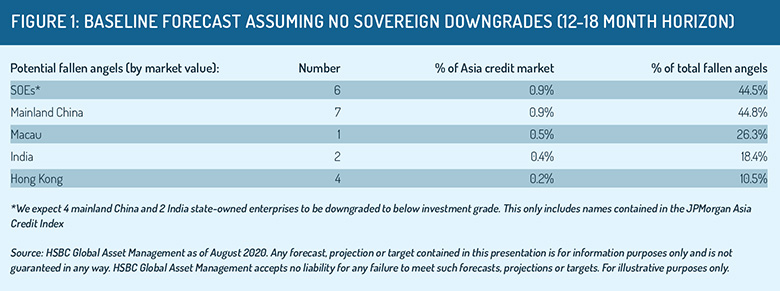 Close to a quarter of global investment grade bonds are yielding negative rates. This is perhaps no surprise, as policy rates have been slashed to record lows in response to the pandemic, writes HSBC’s Elizabeth Allen.
The low rate environment has now turned into a “lower-for-even-longer” scenario following the US Federal Reserve’s recent shift in strategy to adopt an average inflation targeting regime. With low rates here to stay for longer, there will be a prolonged search for yield by global investors.
Against this backdrop, one market that stands out from a risk-reward perspective is Asia credit. The market benefits from a yield advantage versus other comparative markets but doesn’t come with the higher risks that are often associated with higher yields.
Credit quality and the ‘fallen angel’ effect
Close to a quarter of global investment grade bonds are yielding negative rates. This is perhaps no surprise, as policy rates have been slashed to record lows in response to the pandemic, writes HSBC’s Elizabeth Allen.
The low rate environment has now turned into a “lower-for-even-longer” scenario following the US Federal Reserve’s recent shift in strategy to adopt an average inflation targeting regime. With low rates here to stay for longer, there will be a prolonged search for yield by global investors.
Against this backdrop, one market that stands out from a risk-reward perspective is Asia credit. The market benefits from a yield advantage versus other comparative markets but doesn’t come with the higher risks that are often associated with higher yields.
Credit quality and the ‘fallen angel’ effectBeyond its yield advantage, the Asia USD bond market has an overall solid credit quality. Its average credit rating is BBB+ and three of the top five countries or regions in the universe have a sovereign credit rating of A+ or above. The composition is such that state-owned enterprises and government-related entities make up a sizeable proportion of the universe. This underscores the stability of the market as the strong government support seen in the post-pandemic environment could help relieve possible stress on companies’ financial profiles. Globally, the topic of fallen angels has gained increasing attention this year, particularly amidst the challenging economic circumstances caused by the pandemic. Fallen angels refer to bonds with a newly acquired high yield status, having been cast out of the investment grade realm following a ratings downgrade. There lies a broader concern that if a large number of BBB bonds – which are rated investment grade, but are only one category above high yield – are downgraded to high yield, the high yield bond market, which generally has a different subset of investors, would not be able to absorb such a big volume of bonds. In this regard, Asia credit has a structural advantage as the market size of its BBB-rated bonds is approximately the same size as its high yield universe. This is in stark contrast to the market size of BBB-rated bonds in Europe and the US, which is about three to four times the size of their respective high yield markets. Based on our credit research team’s forecast, over a 12 to 18-month horizon, fallen angels should only make up about 2.5% of the Asia USD investment grade bond market (or 8.5% of the Asia USD high yield market). In an extremely conservative forecast, the proportion of fallen angels would be 6.5% of the Asia USD investment grade bond market – which would also be a manageable scenario in our view. The low fallen angel risk in Asia credit is a reflection of the strong and stable credit quality of its investment grade companies. Asia’s default rate expectations
Another cause of concern for investors globally has been the rise in defaults since the start of the pandemic. In this respect, Asia high yield has so far fared better than other markets, with a year-to-date default rate of 2.2%, which is markedly lower than the US high yield market at 6.0%1. Defaults in Asia bonds this year have been idiosyncratic, with the bulk of default situations coming from predominantly small companies within the Chinese industrial sector. On a full-year basis, the default rate in Asia high yield is still forecasted to be lower than in other global markets2. The lower default rate in Asia credit can be attributed to a number of factors. Firstly, going into the pandemic, Asian issuers were on relatively strong footing, particularly given their heavy issuance in 2019 and the access to capital through the last few years. Secondly, Asia ex-Japan is one of the only regions in the world that is still expected to see a positive GDP growth in 2020, and the economic recovery is already underway for certain Asian markets, especially for mainland China. Another advantage is the Asia credit market’s limited exposure to the oil sector, which has helped shield issuers from the blow of the oil price plunge. Undeniably, the Covid-19 pandemic has brought about varying degrees of challenges to different Asian economies and their people. The overall impact has been mitigated by a number of factors, including the accommodative funding conditions in the local markets, support from Asian central banks and governments as well as the overall easing bias globally. But it must be stressed that bottom-up security selection is crucial for any high yield bond market. Particularly in this environment, it’s important for managers to have a strong credit selection team and process in place to focus on credit fundamentals, identify mispricing opportunities and avoid investments with potential credit deterioration and defaults. Long-term considerations
Beyond the pandemic and the cyclical issues, the case for diversifying into Asia credit remains intact. While on the face of it, the yield premium held by Asia credit over other comparative markets is a key beneficial feature, the stability of Asia credit is also bolstered by much lower levels of duration than other global credit markets. In addition, Asia credit has the strong support of its local investors, including healthy investor interest from China and other Asian countries. Local investor demand is one of the reasons why Asia credit is less susceptible to changes in market sentiment in both emerging and global markets in general. We saw this in action during the March 2020 sell-off – Asia investment grade bonds saw a smaller drawdown versus their US and emerging market counterparts. This helps explain why Asia credit exhibits lower correlation to credit in other regions and offers meaningful diversification within a broader global portfolio.
 1, 2 – Source: JP Morgan as of August 2020
Elizabeth Allen is head of global credit research for Asia-Pacific at HSBC Global Asset Management
© 2020 funds globla asia
1, 2 – Source: JP Morgan as of August 2020
Elizabeth Allen is head of global credit research for Asia-Pacific at HSBC Global Asset Management
© 2020 funds globla asia 
 At times like these, HSBC Asset Management easily pivots towards emerging markets.
At times like these, HSBC Asset Management easily pivots towards emerging markets. A comprehensive, cost-effective, and transparent currency overlay hedging solution is crucial to mitigate FX exposure risks in the complex landscapes of Japan and China's FX markets, explains Hans Jacob Feder, PhD, global head of FX services at MUFG Investor Services.
A comprehensive, cost-effective, and transparent currency overlay hedging solution is crucial to mitigate FX exposure risks in the complex landscapes of Japan and China's FX markets, explains Hans Jacob Feder, PhD, global head of FX services at MUFG Investor Services. The world is transitioning from an era of commodity abundance to one of undersupply. Ben Ross and Tyler Rosenlicht of Cohen & Steers believe this shift may result in significant returns for commodities and resource producers over the next decade.
The world is transitioning from an era of commodity abundance to one of undersupply. Ben Ross and Tyler Rosenlicht of Cohen & Steers believe this shift may result in significant returns for commodities and resource producers over the next decade. Ross Dilkes, fixed income portfolio manager at Wellington Management, examines the opportunities and risks for bond investors presented by the region’s decarbonisation agenda.
Ross Dilkes, fixed income portfolio manager at Wellington Management, examines the opportunities and risks for bond investors presented by the region’s decarbonisation agenda. Shareholders in Japan no longer accept below-par corporate governance standards. Changes are taking place, but there are still areas for improvement, says Tetsuro Takase at SuMi Trust.
Shareholders in Japan no longer accept below-par corporate governance standards. Changes are taking place, but there are still areas for improvement, says Tetsuro Takase at SuMi Trust. Robert St Clair, head of investment strategy at Fullerton Fund Management, explores the reasons investors should be paying attention to the rising demand for healthcare in China.
Robert St Clair, head of investment strategy at Fullerton Fund Management, explores the reasons investors should be paying attention to the rising demand for healthcare in China.


